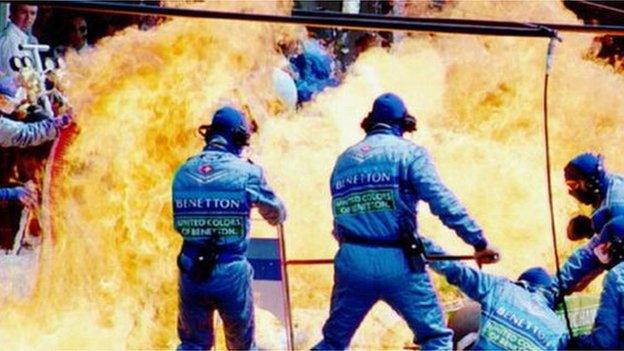F1 rule changes: What do they mean for the future of the sport?
- Published
- comments
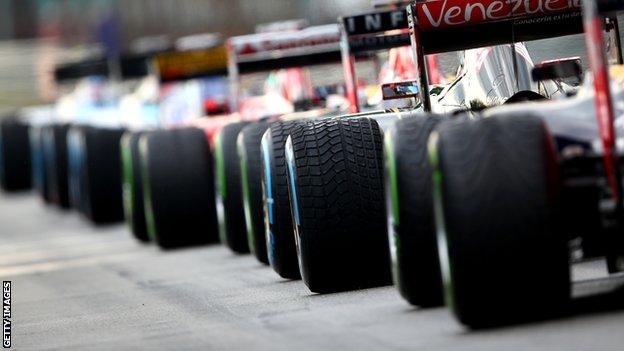
Tyres, refuelling and new aerodynamics will reshape and speed up F1 in 2017
The raft of potential changes to the Formula 1 rules announced on Friday amounts to a recognition that something needed to be done to answer the ever-louder questions about the health of the sport.
There have been grumblings about whether F1 was providing enough of a spectacle for some time, but they have grown in momentum in recent weeks.
And on Monday BBC co-commentator David Coulthard finally revealed to the public what many in F1 already knew - the drivers don't like the current cars because they think they are too slow and too limited by artificial restraints.
A large part of the reason for that is down to the tyres, which was not addressed by the decisions made by the strategy group on Thursday.
But much has been addressed - and the answers F1's bosses have come up with would create a very different-looking sport in two years' time if they are confirmed.
The headline change is the return of refuelling for 2017, along with cars that will be between five and six seconds a lap faster.
The step-change in speed will be welcomed by drivers and fans alike - the current cars are at some tracks as much as 10 seconds a lap slower in race trim than they were in 2004.
How will they be speeded up?
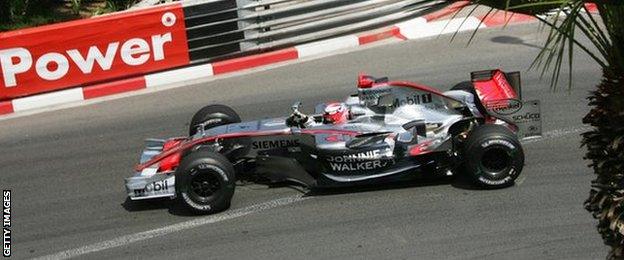
Kimi Raikkonen set the fastest ever lap at Monaco while at McLaren - that was nine years ago
With changes to aerodynamics to increase downforce and make the cars look "more aggressive" - wider cars, with bigger front and rear wings and wider rear tyres - and by reducing weight.
Engines will also rev higher and be louder - addressing the complaints of some fans and F1 commercial supremo Bernie Ecclestone about the new turbo hybrid engines.
This will be done by reducing the number of gears from eight to six, which will force teams to rev higher than the 11,000rpm or so they use now - out of a limit of 15,000rpm.
Engineers have been tasked with finding solutions to make the engines louder, perhaps by adding another exhaust pipe.
That satisfies Ecclestone's demand for more noise, while retaining the hybrids, which was important to the engine manufacturers - and increasing the fuel-flow limit would have meant an expensive redesign to enable engines to cope with what would have been vastly increased power outputs in qualifying.
How much slower are they? | |||
|---|---|---|---|
Race (track) | Lap record | 2014 fastest lap (race) | Difference |
Italian (Monza) | 1:21.046 (2004) | 1:28.004 | -0:06.958 |
Belgian Spa) | 1:47.263 (2009) | 1:50.511 | -0:03.248 |
Monaco | 1:14.439 (2004) | 1:18.479 | -0:04.040 |
British (Silverstone) | 1:33.401 (2013) | 1:37.176 | -0:03.775 |
Brazilian (Interlagos) | 1:11.473 (2004) | 1:13.555 | -0:02.082 |
The fuel-flow limit - which has driven the engineers to develop F1 engines with thermal efficiency in excess of 40% - is also central to the development route of these engines - raise it, and they become far less relevant to current road car research.
On that front, these new engines have been a conspicuous success.
Only last weekend at the Spanish Grand Prix, Mercedes engine boss Andy Cowell was talking about how the device that recovers energy from the turbocharger - which has been criticised as unnecessary and expensive - will soon be adopted in road cars on a widespread basis.
Having 1,000bhp engines was discussed over the winter, but the idea of making changes to facilitate this has been quietly dropped.
Although, as the best engines are about 900bhp already, it may well happen through normal development anyway.
Why refuelling?
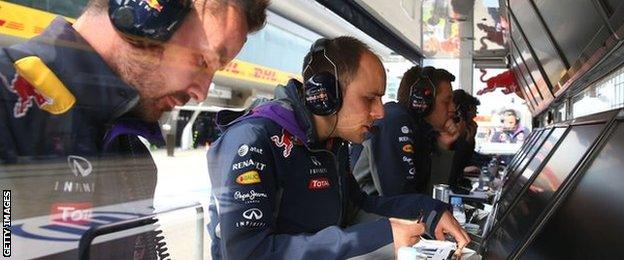
Refuelling was last undertaken in Formula 1 in 2008
All of the technical changes to cars and engines had been widely discussed for months, but the reintroduction of refuelling came out of the blue.
Reaction from fans on social media was immediate and split down the middle - some cheering it, some saying it would lead to a lack of overtaking on the track.
But it's not hard to see where the bosses might be coming from.
For one, without having to carry the maximum fuel load at any time, cars will be faster in the races from the off, taking the sting out of criticisms that they are too slow.
Likewise, less load on the tyres means the drivers might be able to push the tyres harder - a criticism of the current situation with Pirelli, when drivers are often well within themselves for the majority of the race distance because pushing hard overheats the tyres and reduces their life.
Pirelli would have to change the tyre design for it to make any significant difference on that front, though - because the current tyres generally cannot be pushed flat out for any more than a handful of laps, no matter what the fuel load.
It also gives F1's bosses more flexibility when it comes to choosing which company will supply tyres after Pirelli's contract ends in 2016.
Harder, more demanding racing?
The drivers would love to have tyres on which they could drive flat out at all times, including throughout the race distance, as they could during the tyre war between Michelin and Bridgestone in the 2000s, and even in the years of Bridgestone as a monopoly supplier from 2007-10.
Few have been more critical of the current tyres over the last few years than the active driver who was most successful in those pre-Pirelli years - Fernando Alonso.
Many insiders - drivers, engineers and team bosses - will privately admit they wish Michelin would come back, for no company is regarded more highly when it comes to providing strong, consistent, grippy tyres for circuit racing.
That is a long shot, though.
New F1 rules at a glance | |
|---|---|
The change | The outcome |
Aerodynamic rules evolution, wider tyres, reduction of car weight | Faster cars (five to six-second drop in lap times) |
Reintroduction of refuelling (maintaining a maximum race fuel allowance) | Faster cars and potentially better tyre life |
Higher-revving engines | Louder cars |
Ecclestone made it pretty clear in an interview this week that he is not keen on a Michelin return, external.
His opinion that the French company would "make a rock-hard tyre that you could put on in January and take off in December" was immediately rejected as inaccurate by BBC F1 analyst Allan McNish, who raced on Michelin tyres for 18 years in sportscars and F1.
But Ecclestone is well known for making public statements for effect, not necessarily because they bear any relation to the truth.
Senior sources say the reality is that the 84-year-old wants Pirelli to stay largely because of the attractive commercial terms the Italian company offers, rather than any technical or sporting reason.
Formula 1: Jolyon quick in testing, refuelling to return, and Audi in F1?
F1 will discuss what requirements it wants of its tyres come 2017. Ecclestone has already indicated to senior insiders that the new contract will almost certainly go to Pirelli again in 2017.
What the return of refuelling does mean is that whoever is supplying the tyres could afford to make more durable rubber - on which drivers could push harder for longer - without that risking a reduction in pit stops.
This is important, because Ecclestone believes multiple pit stops are a vital element of a good F1 show.
Introducing refuelling will mean there will always be pit stops - and usually, although not always, more than one per driver in each race.
That's because of the speed advantage created by running less fuel - when every 10kg removed equates to on average 0.35secs in lap time.
What happened to cost-cutting?
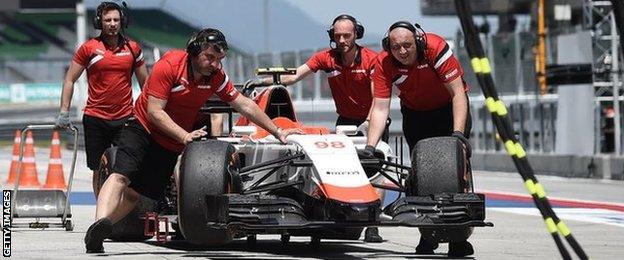
The Manor F1 team have suffered from the high costs of F1 this year
There is one major objection to the return of refuelling - it is expensive.
Teams will have to pay to cart all that heavy equipment around the world, a bill that may well run into the millions.
Mercedes F1 boss Toto Wolff questions that figure, but adds that the idea will be dropped if it turns out to cost too much - the big teams are not unaware of or unsympathetic to the financial burden on the smaller teams, who are already finding F1 budgets onerous.
For the likes of Lotus, Sauber, Force India and Manor, there was little help from the strategy group.
No cost-cutting measures were agreed, and bosses continue to pursue the concept of customer cars.
But this is only a contingency plan should some of the smaller teams fail. And the detail of what is worked out is not simply going to be Red Bull or Ferrari selling cars to smaller outfits.
The plan is to make it possible, should it be necessary, for some teams to buy chassis from others should they want to - and the 'selling teams' could include the likes of Williams - who operate on not much more of a budget than Force India or Lotus - as well as McLaren and Mercedes.
Or struggling teams can continue as customers if they can make the numbers add up.
No-one really wants customer cars. The strategy group is simply providing the sport an option should smaller teams run out of money, whether by misfortune or mismanagement.
- Published12 May 2015

- Published15 May 2015

- Published15 May 2015
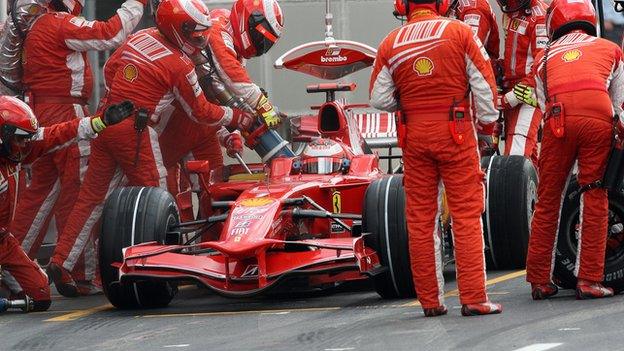
- Published13 May 2015

- Published10 May 2015
